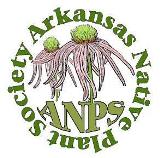Long-Flower Cornsalad (Valerianella longiflora) of the Cornsalad (Valerianaceae) family is an intruigingly branched, herbaceous annual with white flowers with long purple floral tubes. The genus name is the diminutive of Valeriana, the type genus of the Valerianaceae, a name honoring the Roman emperor Valerianus. The specific epithet refers to the flowers’ long floral tubes. In the U.S., the species is endemic to east-central Oklahoma and west-central Arkansas. In Arkansas, more specifically, it occurs in the western Ozark Plateaus, Arkansas River Valley and Ouachita Mountains. The common name “Cornsalad” highlights the use of young plants of some of the species in salads, primarily the non-native Valerianella locusta. Habitat preference is well-drained rocky to sandy soils in full to mostly sunny sites, such as short-grass areas of prairies and glades, woodland openings, and mowed areas of fields and highways.
Taprooted plants first appear as low-growing rosettes of simple spatulate leaves, much like those of other species of Cornsalad. They will reach a height of about 16 inches. A single erect stem divides into paired opposite branches (dichotomous branching) with the final division terminating in the inflorescence. The 2-6 pairs of branches are each subtended by an opposite pair of leaves. The angle between paired branches is fairly constant at about 30⁰ with pairs being rotated by up to 90⁰ from one pair to the next. Stems are hollow, glabrous, and yellowish green, with purplish shading where exposed to more sunlight. They are slightly ridged making them hexagonal in cross-section. Colonies of the plants tend to be about the same height with branches intertwining with other forbs and grasses.

Opposite, clasping leaves fully encircle the stem at their base. Leaves below the lowest pair of branches (“lower leaves”) tend to be of similar size, to 2½ inches long and ⅜ inch wide. Leaf pairs above the lowest pair of branches (“upper leaves”) decrease quickly in size to the point that those subtending the peduncles (stalks of the inflorescence) may be ⅛ inch long and 1/16 inch wide. While shape of lower leaves changes from spatulate to oblong, upper leaves are mostly oblong, grading to lanceolate. The soft yellowish green leaves have entire (uncut) margins and mostly rounded apexes. Pinnate venation is obscure except for the lighter colored and slightly recessed upper midvein and expressed lower midvein.
The Cornsalads have cymose inflorescences that are extremely structurally complex. The following guided tour of the Long-Flower Cornsalad inflorescence is probably best understood by examination under the bright light of a dissecting microscope: A plant with four stem/branch divisions would have 16 peduncles (see Photo 2), growing to ½ -1 inch long, subtended by the uppermost pair of leaves. Each peduncle terminates with a flat-topped floral cluster (“primary cluster”) with a mature base that is from ½ inch long and ¼ inch wide, with that size expanded by the flower cluster. Primary clusters bear about 16 flowers divided into two adjoining clusters (“secondary clusters”). Secondary clusters are subtended by a matched pair of small broadly lanceolate (⅛ inch by 1/16 inch) “basal bracts” along with similarly shaped and sized “floral bracts”. Floral bracts, which subtend flowers at the exterior of clusters, are immediately above and in contact with the basal bracts. In addition to the bracteate flowers, single un-bracteate flowers also occur: 1) between the peduncles at the tip of the branch and 2) between paired secondary clusters. Basal and floral bracts are oval with a sharp tip and spiky ciliate margins (see Photo 3). Peduncles and bracts are a pale green with bracts, especially their tip and margins, highlighted in purple. A plant’s overall inflorescence may be to 10 inches wide, depending on habitat and plant crowding.



Flowering, over a month in April-May, begins with the bractless flower and continues with the bracteate flowers. In bud, the corolla has a white spherical shape atop a long purple tube. Fully open flowers have five widely flared (to 1/4 inch wide), obovate, white corolla lobes and a 3/8 inch long and less than 1/64 inch wide corolla tube. The gynoecium comprises a single pistil (stigma, style and ovary), the androecium 3 stamens, inserted on the corolla tube. Flowers are epigynous––the ovary is inferior, with the corolla attached at its summit. When flowers initially open, the elongate white anthers, center-balanced on the extremely slim filaments, are held directly above the half-hair-sized style. Once pollen has been shed, filaments reflex tightly between the corolla lobes (becoming purple). With stamens in this position, the extremely tiny stigma trifurcates to expose stigmatic surfaces.



With fertilization, 1 of a flower’s 3 carpels develops a viable seed (the other 2 are infertile) as the plant dies. The almost round and somewhat flattened, chubby fruits (less than ⅛ inch across) have a smoothly rounded side and a side with a longitudinal groove. The unusual fruit shape is the product of the fertile middle carpel being bounded by compressed, parallel infertile carpels. The tawny brown seeds are glabrous.

For a garden or natural area, Long-Flower Cornsalad would be a welcome, showy annual plant, often seeding to a lovely colony. If self-seeding becomes a problem, spreading may be controlled by removal of excess plants before fruits mature. However, it would be ideal for a prairie setting where it can feely mix with other spring-blooming annuals and grasses. It provides nectar and pollen for small bees and flies. It is not favored by deer.

Six other species of the genus occur in Arkansas. Of the other six, Ozark Cornsalad (Valerianella ozarkana) has the most similar flowers, with long purplish tubes. Ozark Cornsalad may be distinguished primarily by its usually longer, three-angled, oblong fruits with three lines of pubescence (a form with smaller, rounded, glabrous fruits may sometimes be encountered). Ozark Cornsalad is found primarily in the Ozark Highlands, with scattered occurrences in the Boston Mountains and Arkansas Valley.
Article and photographs by ANPS member Sid Vogelpohl

